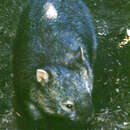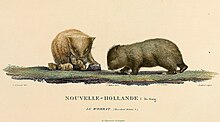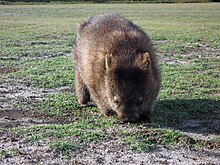en
names in breadcrumbs


The common wombat communicates to conspecifics in a number of ways, mainly through scent marking to maintain territories. Other forms of communication include vocalizations, aggresive displays, and markings on logs and branches made by rubbing against them repeatedly.
Communication Channels: visual ; acoustic ; chemical
Other Communication Modes: scent marks
Perception Channels: visual ; tactile ; acoustic ; chemical
According the the IUCN Red List for Threatened Species, coarse-haired wombats are listed as least concern, and the population trends are currently stable. They are protected in all states of Australia.
IUCN Red List of Threatened Species: least concern
Wombats are sometimes seen as pests in areas of farming due to their burrowing behavior creating hazards for livestock. Also, wombats sometimes burrow under rabbit fences, allowing rabbits an escape path.
Wombats were hunted for their pelts; now they are protected and it is illegal.
Wombats often live in riparian environments, due to their preference to build burrows above creeks and streams. Due to their grazing and soil-displacing habits, wombats may help to provide different microsites that influence vegetative growth patterns in these environments.
Ecosystem Impact: creates habitat
Commensal/Parasitic Species:
The combination of low metabolic activity and a large digestive tract allows wombats to utilize areas where the vegetation may be of poor quality. The common wombat is a folivore, with a diet that consists of native grasses, sedges, moss, and sometimes shrubs, roots, tubers, and bark. The small, acidic stomach and simple small intestine of wombats digests plant cell material, while the hind gut houses microbial fermentation, with which wombats digest the fibrous cell walls of plants. The hind gut consists of a proximal colon (which makes up roughly 60 to 80% of gut contents), a cecum, and the distal colon. Some of the plant species in the wombat diet include Poa, Themeda australis, Carex appressa, Juncas, Stipa, and Danthonia penicillata.
Plant Foods: leaves; roots and tubers; wood, bark, or stems; bryophytes
Primary Diet: herbivore (Folivore )
Wombats are native to the Australian biogeographic region. Coarse-haired wombats are found along the eastern edge of Queensland and New South Whales, in addition to Victoria, Flinder's Island, Tasmania, and parts of South Australia.
Biogeographic Regions: australian (Native )
Coarse-haired wombats inhabit temperate areas with suitable burrowing conditions, which may include areas such as open forests, heathlands, and hilly coastal scrub.
Range elevation: 0 to 1800 m.
Habitat Regions: temperate ; terrestrial
Terrestrial Biomes: savanna or grassland ; forest ; scrub forest
Other Habitat Features: riparian
There are few studies describing wombat longevity; however, the longest a wombat lived in captivity was approximately 30 years. They typically only live 12 to 15 years.
Range lifespan
Status: captivity: 30 (high) years.
Typical lifespan
Status: wild: 12 to 15 years.
Average lifespan
Status: captivity: 26.0 years.
Average lifespan
Status: captivity: 26.1 years.
Coarse-haired wombats are large, squat, thick-set grazers with a broad, rounded head, stubby tail, small dark eyes, and small round ears. Its limbs are short with sturdy claws for burrowing. Wombats have a pair of rootless, ever-growing incisors differs them from marsupials and can be used for cutting through obstacles when burrowing. Its fur is thick and coarse and can range in color from grey-brown to blackish, patchy grey and buff, or uniformly cream colored. Unlike the two other species of wombat, this species lacks hair on its rhinarium, and the ears are smaller and more furred than that of its close relatives. The northern and southern hairy nosed wombats tend toward longer muzzles that are more square-like in shape. Populations of coarse-haired wombats that inhabit Tasmania tend to have smaller members than the mainland, and Flinders Island populations have the smallest members.
Range mass: 20 to 35 kg.
Range length: 700 to 1100 mm.
Other Physical Features: endothermic ; bilateral symmetry
Predators of the common wombat include Tasmanian devils, dogs, wedge-tailed eagles, and humans. Prior to their extinction, Tasmanian wolves probably preyed on the wombats, as well. The combination of low metabolic rate and efficient digestion allows wombats to spend much of their time in their burrows away from predators, though wombats likely have these traits to exploit a diet of poor-quality vegetation and not to avoid predation. Wombats sometimes build dirt plugs to close off their tunnels, which may be a defensive behavior.
Known Predators:
Anti-predator Adaptations: cryptic
Coarse-haired wombats reproductive behavior consists of a male chasing the female in circles for several minutes at a time until the female slows down enough for him to catch up. At this point he bites her rump, grasps her with his forelegs, and flips her onto her side. The male then mounts her while laying on his side; after which the female may break off into a jog, and the chasing behavior ensues again. These sessions may last about 30 minutes. Not much is known about wombat mating systems, but there is some evidence to suggest that they are polygynous.
Mating System: polygynous
Coarse-haired wombats typically breed and produce one offspring about every two years. Their breeding doesn't seem to be tied to any particular season, though births may be clustered in summer. Gestation lasts approximately one month, producing a tiny joey about the size of a jelly bean. This joey grows in the pouch until it is weaned at approximately 12 months of age. Both male and female wombats are sexually mature after about 2 years.
Breeding interval: Common wombats breed about once every two years.
Breeding season: Reproduction is not strongly linked to seasons.
Average number of offspring: 1.
Range gestation period: 27 to 31 days.
Range weaning age: 12 to 20 months.
Range time to independence: 18 to 20 months.
Average age at sexual or reproductive maturity (female): 2 years.
Average age at sexual or reproductive maturity (male): 2 years.
Key Reproductive Features: iteroparous ; year-round breeding ; gonochoric/gonochoristic/dioecious (sexes separate); sexual ; viviparous
Average birth mass: 0.5 g.
Average number of offspring: 1.
Average age at sexual or reproductive maturity (male)
Sex: male: 730 days.
Average age at sexual or reproductive maturity (female)
Sex: female: 730 days.
After birth, the wombat joey will live in its mother's pouch for about 6 months, feeding off the mothers milk until about 15 months of age. The wombat will remain with its mother until about 18 to 20 months of age, until it gains its independence.
Parental Investment: altricial ; female parental care ; pre-hatching/birth (Provisioning: Female, Protecting: Female); pre-weaning/fledging (Provisioning: Female, Protecting: Female); pre-independence (Provisioning: Female, Protecting: Female)
The common wombat (Vombatus ursinus), also known as the coarse-haired wombat or bare-nosed wombat, is a marsupial, one of three extant species of wombats and the only one in the genus Vombatus. The common wombat grows to an average of 98 cm (39 in) long and a weight of 26 kg (57 lb).

The common wombat was first described by George Shaw in 1800. There are three extant subspecies:
Hackett's wombat (V. hacketti) is an extinct species of genus Vombatus, inhabiting the southwestern part of Australia.[9][10][11][12] Being around the same size as V. ursinus, with an average weight of 30 kg, V. hacketti went extinct at the end of the Late Pleistocene, in the Quaternary extinction event.[13][14]
Common wombats are sturdy and built close to the ground. When fully grown, they can reach between 80 and 130 cm, and weigh between 17 and 40 kg. The wombats found on Tasmania and Flinders Island are often smaller than their mainland counterparts. It is distinguished from both hairy-nosed wombats by its bald nose.

Common wombats are widespread in the cooler and better-watered parts of southern and eastern Australia, including Tasmania and Victoria, and in mountain districts as far north as southern Queensland.[15][16]
Common wombats can be found at any elevation in the south of their range, but in the north of their range are only found in higher, more mountainous areas. They may be found in a variety of habitats including rainforest, eucalyptus forest, woodland, alpine grassland, and coastal areas.[17] In some regions, they have adapted to farmland and can even be seen grazing in open fields with cattle and sheep.
Common wombats have been described as ecological engineers,[18] as their burrow building results in soil turnover and aeration, which assists plant growth, and provides habitat for a range of invertebrate and vertebrate species.[19][20]
Common wombats are a solitary, territorial species, with each wombat having an established range in which it lives and feeds.[21] In this area, they dig a tunnel system, with tunnels ranging from 2 to 20 m in length, along with many side tunnels. Usually, only one entrance to the burrow exists, although they may create a smaller one with which to escape.
A wide range of other animals are known to make use of wombat burrows including reptiles, rodents, rabbits, echidnas, wallabies, birds and koalas. Wombats are usually fairly tolerant of non-threatening species, and have a number of burrows that they can occupy.[22][23]
Many wombats can live in the same burrow, and wombats normally live in the same burrow for their whole lifespan unless the wombat is forced out of the burrow by farmers or other animal species, or unless the burrow is destroyed. Often nocturnal, the common wombat does come out during the day in cooler weather, such as in early morning or late afternoon.[24]

Bare-nosed wombats are herbivorous, subsisting on grass, snow tussocks, and other plant materials. Foraging is usually done during the night. They are the only marsupial in the world whose teeth constantly grow. Due to the underlying enamel structure of the teeth, the continuously growing teeth maintain a self-sharpening ridge[25] which allows easier grazing of the diet consisting of mainly native grasses.[24] Captive wombats are also fed a range of vegetables.[26]
The common wombat can breed every two years and produce a single joey. Wombats appear to mate side-ways[27] The gestation period is about 20–30 days, and the young remain in the pouch for five months. When leaving the pouch, they weigh between 3.5 and 6.5 kg (7.7 and 14.3 lb). The joey is weaned around 12 to 15 months of age, and is usually independent at 18 months of age.[24] Wombats have an average lifespan of 15 years in the wild and 20 years in captivity.
Whilst bare-nosed wombats are listed as Least Concern by the IUCN,[28] they remain threatened largely due to anthropomorphic factors[29] including habitat reduction, roadkill[30] and sarcoptic mange.[31] Sarcoptic mange is prevalent in the population[32] and remains the most problematic of issues facing bare-nosed wombats with wildlife carers regularly treating wombats in the field[33][34] with low-risk moxidectin.[35]
Wombats have also been reported to harbour a range of parasites including ticks and associated pathogens[36][37]
The common wombat (Vombatus ursinus), also known as the coarse-haired wombat or bare-nosed wombat, is a marsupial, one of three extant species of wombats and the only one in the genus Vombatus. The common wombat grows to an average of 98 cm (39 in) long and a weight of 26 kg (57 lb).